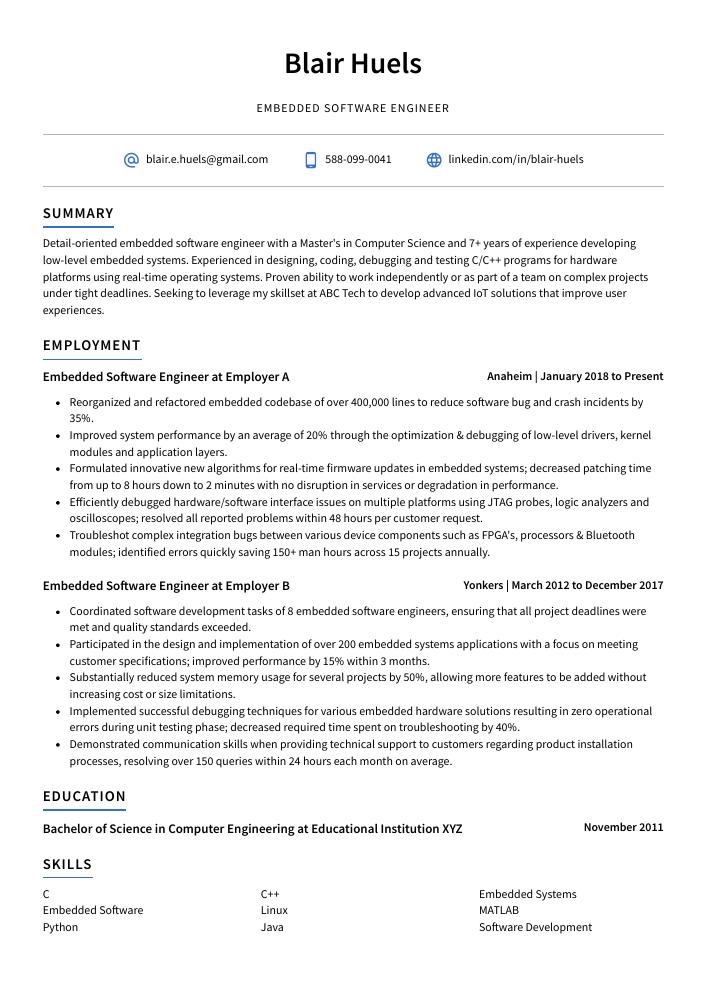Embedded Software Engineer Resume Guide
Embedded software engineers design, develop, and maintain the code that powers embedded systems. They create programs to control hardware devices such as sensors, displays, motors, and other electronic components in a variety of industries including automotive engineering, medical device manufacturing and consumer electronics.
You have the skills and experience to be a great embedded software engineer, but potential employers don’t know who you are. To make them aware of your capabilities, you must write an impressive resume that truly stands out from the competition.
This guide will walk you through the entire process of creating a top-notch resume. We first show you a complete example and then break down what each resume section should look like.
Table of Contents
The guide is divided into sections for your convenience. You can read it from beginning to end or use the table of contents below to jump to a specific part.
Embedded Software Engineer Resume Sample
Blair Huels
Embedded Software Engineer
blair.e.huels@gmail.com
588-099-0041
linkedin.com/in/blair-huels
Summary
Detail-oriented embedded software engineer with a Master’s in Computer Science and 7+ years of experience developing low-level embedded systems. Experienced in designing, coding, debugging and testing C/C++ programs for hardware platforms using real-time operating systems. Proven ability to work independently or as part of a team on complex projects under tight deadlines. Seeking to leverage my skillset at ABC Tech to develop advanced IoT solutions that improve user experiences.
Experience
Embedded Software Engineer, Employer A
Anaheim, Jan 2018 – Present
- Reorganized and refactored embedded codebase of over 400,000 lines to reduce software bug and crash incidents by 35%.
- Improved system performance by an average of 20% through the optimization & debugging of low-level drivers, kernel modules and application layers.
- Formulated innovative new algorithms for real-time firmware updates in embedded systems; decreased patching time from up to 8 hours down to 2 minutes with no disruption in services or degradation in performance.
- Efficiently debugged hardware/software interface issues on multiple platforms using JTAG probes, logic analyzers and oscilloscopes; resolved all reported problems within 48 hours per customer request.
- Troubleshot complex integration bugs between various device components such as FPGA’s, processors & Bluetooth modules; identified errors quickly saving 150+ man hours across 15 projects annually.
Embedded Software Engineer, Employer B
Yonkers, Mar 2012 – Dec 2017
- Coordinated software development tasks of 8 embedded software engineers, ensuring that all project deadlines were met and quality standards exceeded.
- Participated in the design and implementation of over 200 embedded systems applications with a focus on meeting customer specifications; improved performance by 15% within 3 months.
- Substantially reduced system memory usage for several projects by 50%, allowing more features to be added without increasing cost or size limitations.
- Implemented successful debugging techniques for various embedded hardware solutions resulting in zero operational errors during unit testing phase; decreased required time spent on troubleshooting by 40%.
- Demonstrated communication skills when providing technical support to customers regarding product installation processes, resolving over 150 queries within 24 hours each month on average.
Skills
- C
- C++
- Embedded Systems
- Embedded Software
- Linux
- MATLAB
- Python
- Java
- Software Development
Education
Bachelor of Science in Computer Engineering
Educational Institution XYZ
Nov 2011
Certifications
Certified Embedded Software Engineer
International Society of Automation
May 2017
1. Summary / Objective
Your resume summary is like a movie trailer – it should give the employer an overview of who you are and why they should hire you as an embedded software engineer. In this section, highlight your most impressive skills and accomplishments. For example, mention the programming languages you specialize in, any certifications or awards related to embedded systems development that you have earned, and how your work has helped improve customer satisfaction ratings at previous companies.
Below are some resume summary examples:
Driven embedded software engineer with over 5 years of experience in developing embedded systems for various applications. Expertise in C/C++ programming, RTOS development and debugging, real-time system design and implementation, microcontroller architecture, digital signal processing (DSP), hardware interfacing & communication protocols such as I2C/UART/CAN etc. Proven track record of delivering projects on time by working collaboratively in cross-functional teams.
Professional embedded software engineer with 8+ years of experience in designing and developing embedded systems for consumer electronics. Proven track record of successfully delivering projects within tight deadlines by utilizing C/C++, Python, Assembly language, and other programming languages. Skilled at troubleshooting complex issues related to hardware and firmware development. Experienced in debugging system malfunctions using logic analyzers or oscilloscopes.
Talented embedded software engineer with 5+ years of experience in embedded C and assembly development. Skilled in designing, debugging, and testing real-time applications for microcontrollers. Experienced in working on a wide range of projects from medical equipment to consumer electronics at ABC Company. Led the project team responsible for developing an innovative security solution that was awarded by IEEE as one of the top 10 inventions of 2018.
Committed embedded software engineer with 8+ years of experience in developing and debugging embedded systems. Skilled at integrating hardware, firmware, and software components to create a complete system solution. Proven ability to troubleshoot issues quickly by utilizing creative problem-solving techniques. Seeking to join ABC Tech as an embedded software engineer where I can leverage my skills and knowledge for the benefit of the organization.
Skilled embedded software engineer with 5+ years of experience in developing embedded systems for consumer electronics. Proven track record of completing projects on time and under budget, while meeting customer requirements. Expertise in C/C++ programming languages, RTOSs (Real-Time Operating Systems), and ARM microcontrollers. Successfully designed algorithms for complex applications such as speech recognition and image processing.
Dependable and detail-oriented embedded software engineer with a proven track record of success in designing and developing efficient and effective hardware/software solutions. Expertise in C, Assembly, Python, RTOSs (VxWorks), ARM Cortex M3 & M4 processors. Experienced in creating detailed technical documents for project planning and client presentations as well as debugging complex systems to ensure optimal performance.
Accomplished embedded software engineer with 8+ years of experience developing and maintaining embedded systems for various industries. Successfully reduced development time by up to 20% by streamlining processes, such as code refactoring, debugging and testing. Looking forward to joining ABC Tech and utilizing my expertise in C/C++ programming language to create cutting-edge products.
Hard-working embedded software engineer with 5+ years of experience developing and designing embedded systems for consumer electronics. Looking to join ABC Tech to utilize my expertise in C++, Python, and Linux Kernel programming on a wide range of cutting-edge projects. In previous roles, I successfully developed over 20 firmware releases while meeting all deadlines.
2. Experience / Employment
In the experience/employment/work history section, you want to list your roles in reverse chronological order. That means the most recent job is listed first.
When writing out what you did, stick to bullet points primarily; this makes it easier for the reader to take in all of the information quickly and easily. When doing so, be sure to provide detail about what you accomplished and any results that were obtained from your work.
For example, instead of saying “Developed embedded software,” try something like “Designed and implemented an embedded system using C++ on a Linux platform which enabled real-time data collection with up to 99% accuracy.”
To write effective bullet points, begin with a strong verb or adverb. Industry specific verbs to use are:
- Designed
- Programmed
- Implemented
- Debugged
- Tested
- Developed
- Optimized
- Refactored
- Analyzed
- Documented
- Troubleshot
- Monitored
- Integrated
- Deployed
- Automated
Other general verbs you can use are:
- Achieved
- Advised
- Assessed
- Compiled
- Coordinated
- Demonstrated
- Expedited
- Facilitated
- Formulated
- Improved
- Introduced
- Mentored
- Participated
- Prepared
- Presented
- Reduced
- Reorganized
- Represented
- Revised
- Spearheaded
- Streamlined
- Structured
- Utilized
Below are some example bullet points:
- Prepared detailed system specifications, design documents and flowcharts for embedded software applications that controlled over 15 different pieces of hardware; reduced development time by 40%.
- Successfully developed and implemented 6 real-time operating systems (RTOS) in various embedded products used in medical devices, industrial automation machines and robots; improved overall product performance by 35%.
- Spearheaded the integration of a state-of-the art Bluetooth communication protocol into an existing device controller using C/C++ language; resulted in a reduction of 25% power consumption.
- Assessed customer requirements to plan out complex designs for firmware architectures with high reliability standards from start to finish within tight deadlines; achieved 100% success rate on projects delivered on time and under budget.
- Tested all codes written during the entire project lifecycle to ensure top quality output before deployment, resulting in 90% fewer bugs reported post release compared to competitors’ products.
- Streamlined development process in embedded software engineering projects, resulting in a reduction of development costs by 20%.
- Utilized programming languages such as C/C++ and Python to design, develop and debug embedded systems for various applications.
- Presented the technical aspects of designs to stakeholders, ensuring accuracy and efficiency before implementation; received positive feedback from team members on project success rate.
- Reduced debugging time by 30% through the use of advanced techniques such as dynamic memory allocation & concurrent processing elements within code base architecture.
- Accurately tested all developed firmware using automated test scripts prior to deployment; identified & resolved nearly 75 bugs during QA testing stages with 95% accuracy rate.
- Refactored existing code of embedded software systems, reducing development cycle by 10% and improving overall performance.
- Facilitated bug fixing initiatives to ensure that all embedded software issues were efficiently resolved in a timely manner; improved system efficiency by 20%.
- Proficiently programmed using C++, Java and Python to develop firmware for various electronic devices across multiple platforms.
- Monitored the status of hardware components such as sensors & actuators using I2C/SPI protocols, ensuring correct functionality of embedded systems at all times.
- Developed automated test scripts for debugging applications on different microcontroller architectures with 80% accuracy rate or higher.
- Achieved a 10% improvement in system performance by developing, testing and deploying embedded software solutions for a variety of applications.
- Deployed over 500 enhanced firmware releases to multiple hardware platforms within tight deadlines, ensuring customer satisfaction levels remained high.
- Designed and implemented cost-effective software solutions that significantly decreased development cycles from 24 hours to 8 hours on average.
- Actively participated in code reviews, bug fixing activities and other quality assurance processes; improved the overall user experience with no reported defects post deployment stages.
- Documented meticulously tested codes & requirements during each release cycle; reduced debugging time by 25%.
- Automated embedded software development and testing processes to reduce engineering time by 15%, saving $10,000 in labor costs.
- Integrated the latest technologies into embedded systems for a range of consumer electronics products, resulting in an average improvement of 20% on performance metrics.
- Revised existing firmware codebase using C++ and Bash scripting languages to enhance system efficiency by 30%.
- Confidently identified potential errors within complex software algorithms and debugged them quickly with minimal disruption to operations; reduced downtime by 45 minutes per project on average.
- Advised stakeholders on best practices for managing embedded projects from design phase all the way through post-deployment maintenance, increasing customer satisfaction ratings by 25%.
- Analyzed system requirements and developed embedded software applications to meet the specified needs; optimized existing programs for improved performance, resulting in a 20% increase in speed.
- Represented engineering team at customer meetings and introduced new features that enhanced product usability by 30%.
- Developed low-level drivers for various microcontrollers such as ARM7TDMI, AVR ATmega32 and Intel 8051; prepared detailed technical documentation outlining design methodologies & coding standards used during development process.
- Thoroughly tested all code written using debugging tools like GDB/LLVM debugger, ensuring bug-free application delivery with 100% accuracy rate within tight timelines of two weeks or less per project cycle.
- Built custom libraries of reusable functions that decreased overall programming time by 25%, saving over 500 hours annually on software development tasks across multiple projects simultaneously.
- Expedited the development of embedded software applications by 10% through the utilization of object-oriented programming languages and debugging tools.
- Compiled detailed design documents, test plans and status reports for 20+ projects in a timely manner to ensure project deadlines were met consistently.
- Developed firmware code for various microcontrollers such as ARM7, 8051 and AVR; successfully lowered errors from firmware integration by 17%.
- Structured reliable communication protocols within various operating systems (Linux & Windows) according to customer requirements; designed APIs that enabled easy user interface customization in less than 6 hours on average per application module/task.
- Consistently monitored real-time performance metrics using analytics tools to reduce system downtime issues by 25%.
3. Skills
Skill requirements will differ from one employer to the next; this can easily be ascertained from the job posting. Organization A may require proficiency with C++ and Organization B may require expertise in Python.
It is essential to tailor the skills section of your resume for each job you apply for because many employers use applicant tracking systems (ATS). These programs scan resumes for certain keywords before passing them on to a human, so including relevant ones will increase your chances of being noticed by recruiters.
You should also elaborate on the most important skills in other sections such as summary or experience.
Below is a list of common skills & terms:
- Agile Methodologies
- Algorithms
- Arduino
- Arm
- Assembly Language
- AutoCAD
- C
- C#
- C++
- ClearCase
- Debugging
- Device Drivers
- Digital Signal Processors
- Eclipse
- Electrical Engineering
- Electronics
- Embedded C
- Embedded Linux
- Embedded Software
- Embedded Systems
- Engineering
- FPGA
- Firmware
- Git
- HTML
- I2C
- Integration
- Java
- JavaScript
- LabVIEW
- Linux
- MATLAB
- Microcontrollers
- MySQL
- Object Oriented Design
- Operating Systems
- PCB Design
- PHP
- Perl
- Programming
- Python
- RTOS
- Real Time Operating Systems
- SQL
- Shell Scripting
- Simulations
- Simulink
- Software Design
- Software Development
- Software Engineering
- System Architecture
- Systems Engineering
- TCP/IP
- Teamwork
- Testing
- Unix
- VHDL
- Verilog
- Visual Studio
- VxWorks
- Windows
- XML
4. Education
Including an education section on your resume will depend on how far along you are in your career. If you recently graduated and have no prior experience, mention your education below your resume objective. However, if you have been working as an embedded software engineer for years with plenty of different responsibilities to showcase, omitting the education section is perfectly fine.
If an education section is included, try to mention courses related to the embedded software engineering role you are applying for such as programming languages (C/C++), operating systems (Linux/Unix), microprocessors or hardware design fundamentals.
Bachelor of Science in Computer Engineering
Educational Institution XYZ
Nov 2011
5. Certifications
Certifications demonstrate to a potential employer that you have the knowledge and skills necessary for the job. They also show employers that you are committed to staying up-to-date with industry trends, as certifications often require ongoing education or training.
Including any relevant certifications on your resume can help give hiring managers confidence in your abilities and set you apart from other applicants.
Certified Embedded Software Engineer
International Society of Automation
May 2017
6. Contact Info
Your name should be the first thing a reader sees when viewing your resume, so ensure its positioning is prominent. Your phone number should be written in the most commonly used format in your country/city/state, and your email address should be professional.
You can also choose to include a link to your LinkedIn profile, personal website, or other online platforms relevant to your industry.
Finally, name your resume file appropriately to help hiring managers; for Blair Huels, this would be Blair-Huels-resume.pdf or Blair-Huels-resume.docx.
7. Cover Letter
Including a cover letter with your job application is an effective way to make a great first impression. A cover letter should be concise, yet comprehensive and contain 2-4 paragraphs of information. It provides the opportunity for you to explain why you’re the ideal candidate for the position and showcase qualities that can’t be found in your resume alone.
Though not always required, writing a cover letter gives recruiters valuable insight into who you are as a professional and sets yourself apart from other applicants competing for the same role.
Below is an example cover letter:
Dear Emmie,
I am writing to apply for the position of Embedded Software Engineer at XYZ Corporation. As an experienced software engineer with a strong background in embedded systems, I am confident I can be a valuable asset to your team.
In my current role as an embedded software engineer at ABC Company, I work on a variety of projects developing and maintaining software for embedded systems. My experience includes working with various microcontrollers, real-time operating systems, and communication protocols. In addition, I have experience with hardware interfaces such as SPI and I2C.
I am also familiar with common development tools such as compilers, linkers, assemblers, debuggers, and emulators. In addition to being able to use these tools effectively, I also have experience creating custom scripts and applications to automate various tasks related to firmware development.
The combination of my technical skills and hands-on experience makes me confident that I would be able to contribute positively to your organization. I am eager to put my skills to work on challenging projects that require innovative solutions. If given the opportunity, I am confident that I will exceed your expectations and become a valuable member of your team.
Sincerely,
Blair
Embedded Software Engineer Resume Templates
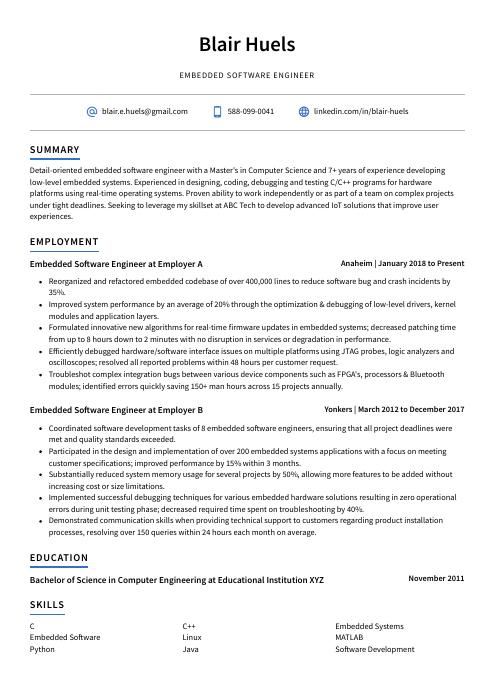 Axolotl
Axolotl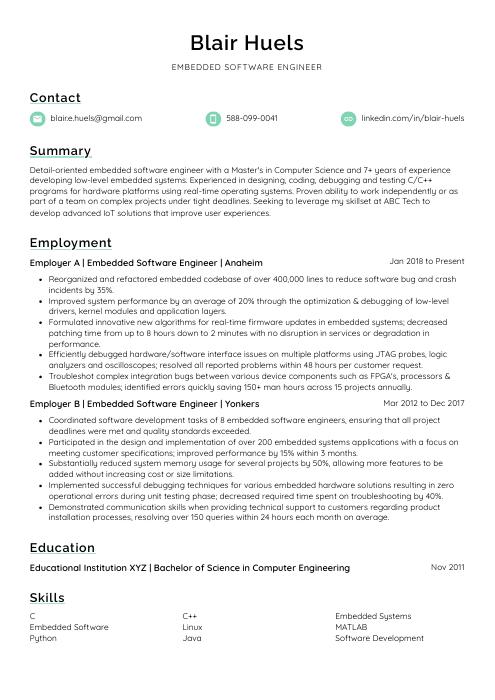 Lorikeet
Lorikeet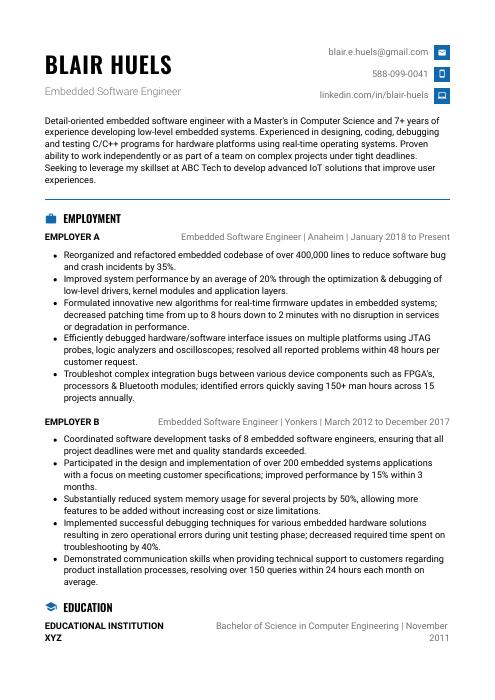 Echidna
Echidna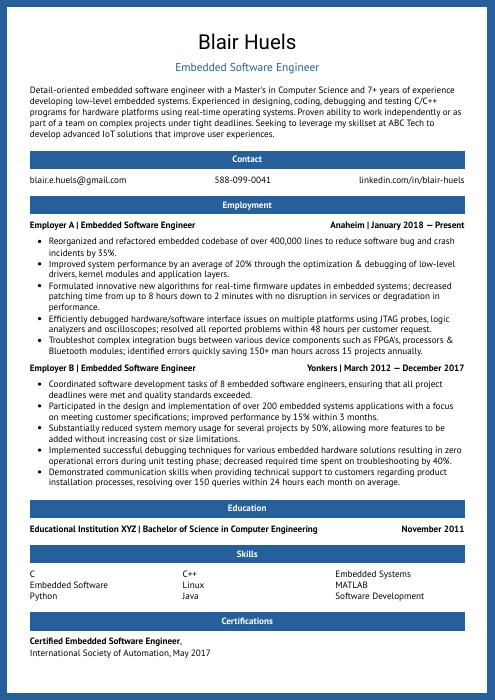 Ocelot
Ocelot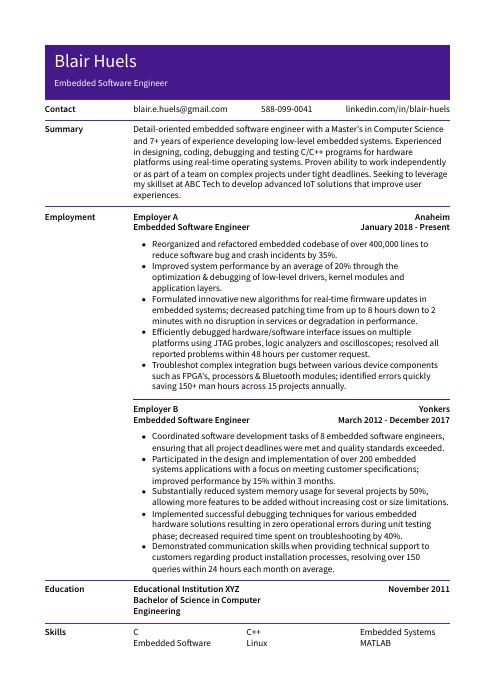 Pika
Pika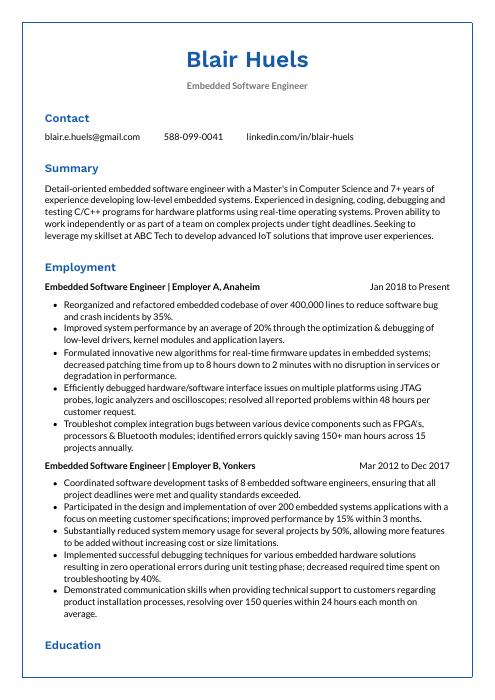 Markhor
Markhor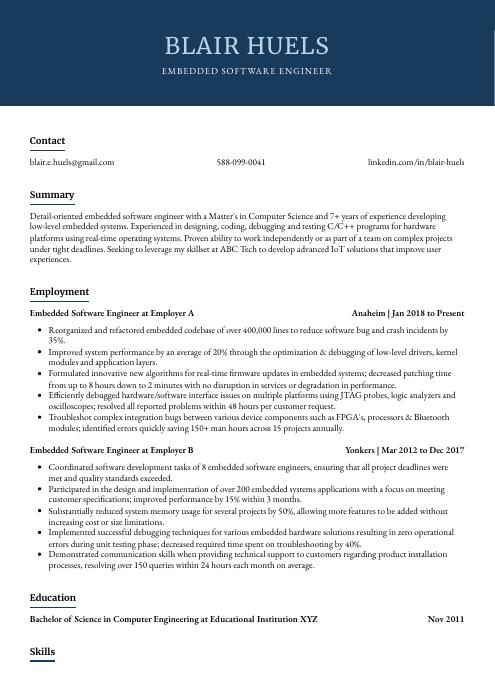 Bonobo
Bonobo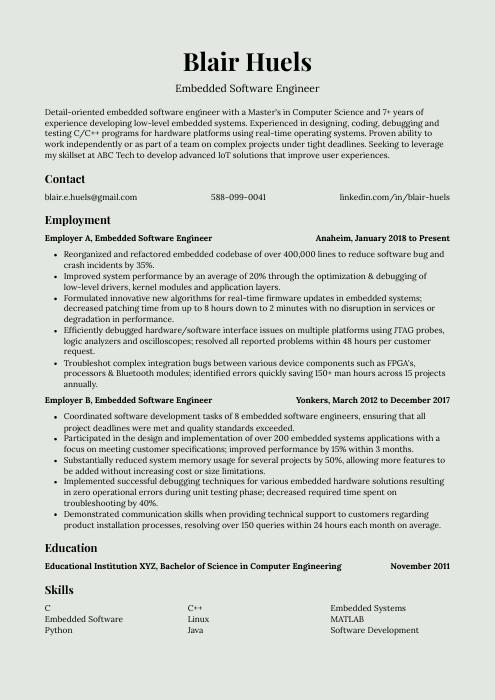 Saola
Saola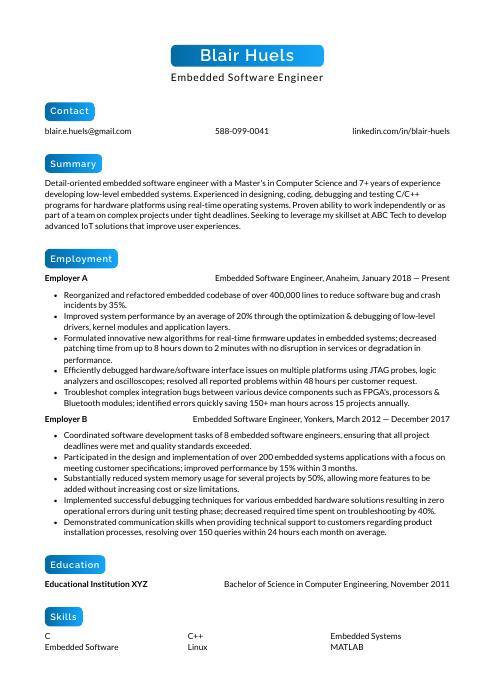 Kinkajou
Kinkajou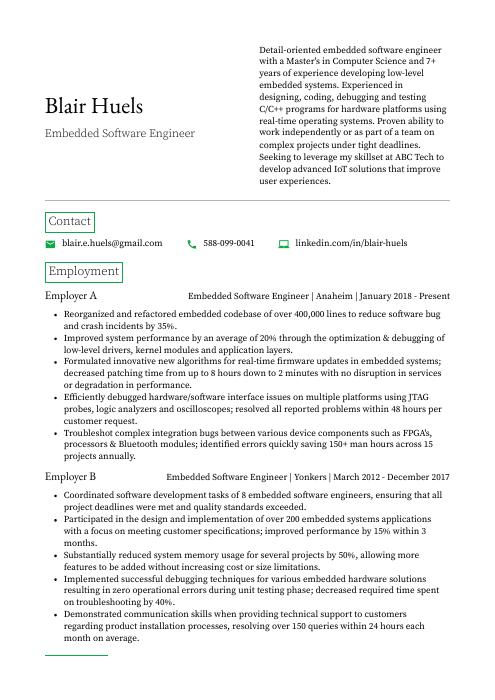 Quokka
Quokka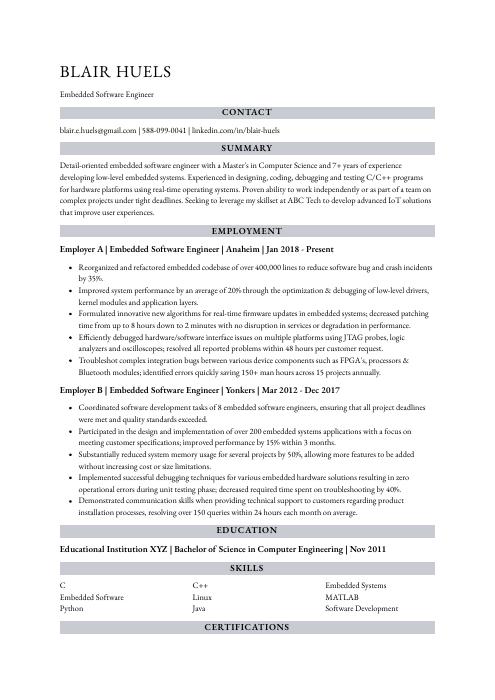 Numbat
Numbat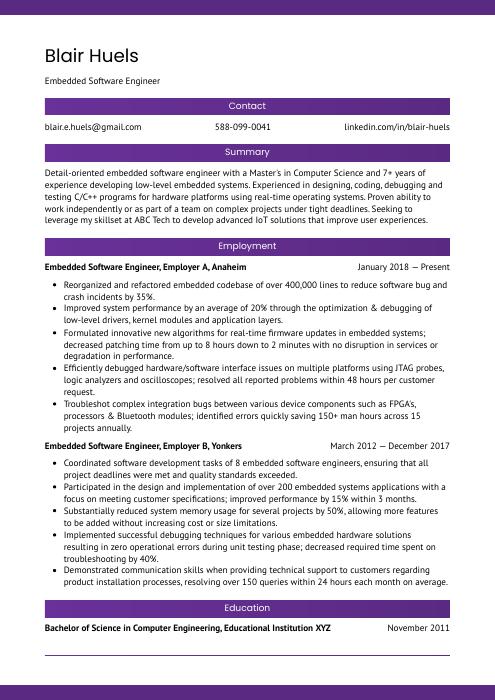 Jerboa
Jerboa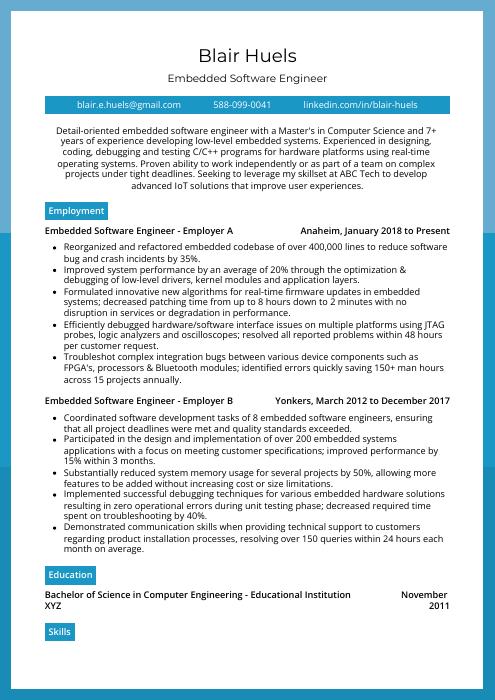 Rhea
Rhea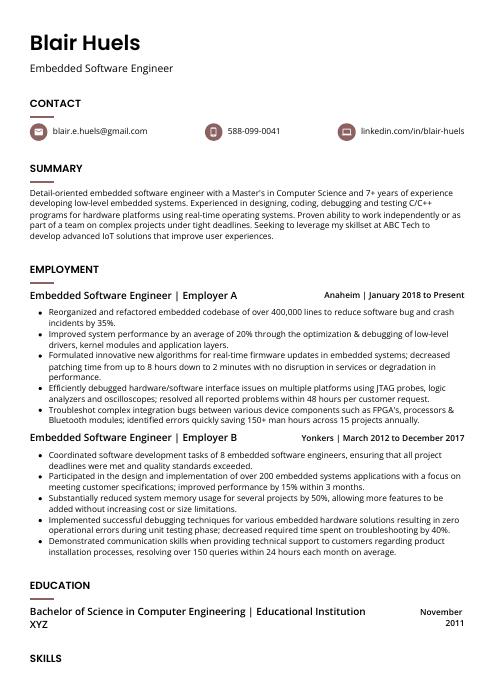 Fossa
Fossa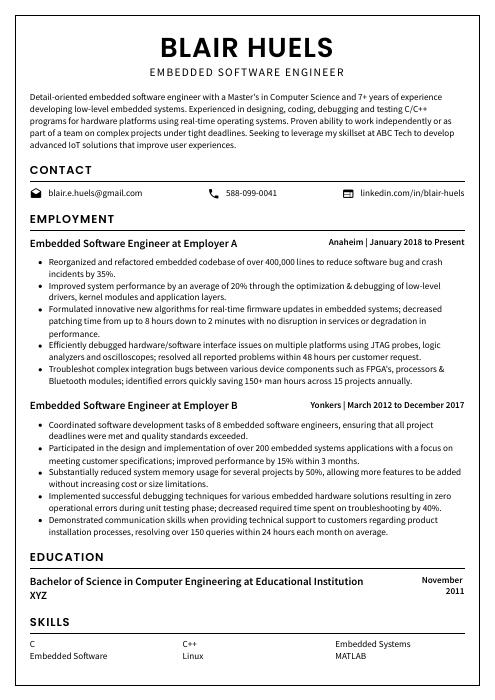 Cormorant
Cormorant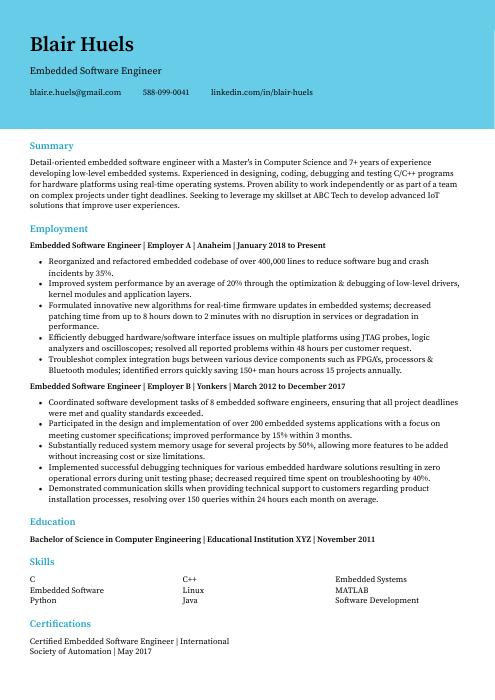 Dugong
Dugong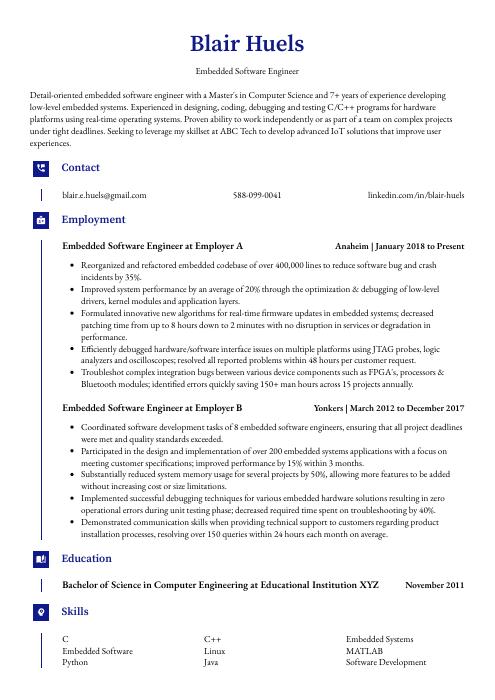 Gharial
Gharial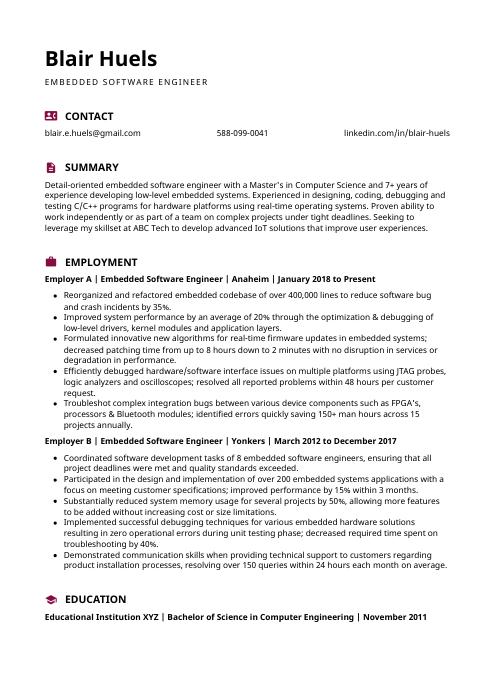 Hoopoe
Hoopoe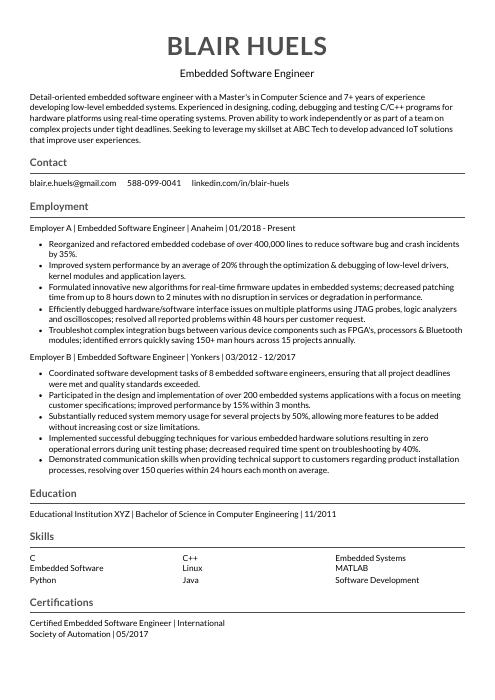 Indri
Indri Rezjumei
Rezjumei
